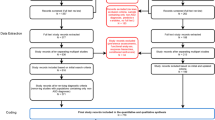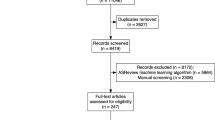Abstract
One key concern of child mental health professionals is the structuring of children's activities so as to enhance their positive behavior and minimize their negative behavior. This paper addresses the relationship between activities and child behavior through a brief review of the literature and a report of a two-fold study which found (1) no significant differences between the percentage of time spent in formal, informal, task, and solitary activities of children with mentally ill parents and children with parents who are not mentally ill and (2) a significant relationship between such activities and the problem behavior exhibited by children with mentally ill parents. Formal activities were significantly associated with lower levels of problem behavior Solitary activities were significantly associated with higher levels of problem behavior. This association was strongest for adolescent girls.
Similar content being viewed by others
References
Barker RG: Ecological psychology.Concepts and methods for studying the environment of human behavior Stanford, CA: Stanford University Press, 1968.
Bronfenbrenner J:The ecology of human development: Experiments by nature and design. Cambridge, MA: Harvard University Press, 1979.
Garbarino J:children and families in the social environment. New York: Aldine, 1982.
Segal J, Yahreas H:A child's journey: Forces that shape the lives of our young. New York: McGraw-Hill, 1979.
Bastiansen S, Stein S, Kringler E: Children of two psychotic parents: A preliminary report. In Cancro R (ed),Annual review of the schizophrenic syndrome, Vol. 3. New York: Brunner/Mazel, 1973.
Mednick BR: Breakdown in high-risk subjects: Familial and early environmental factors.J Abnormal Psych 82: 469–475, 1979.
Moskalenko JD: A comparative study of families with one or both schizophrenic parents.Zhurnal Neuropatologii i Psikriatrii 72: 86–92, 1972.
Rieder RI: The offspring of schizophrenic parents: A review.J Nervous and Mental Disease 157: 179–190, 1973.
Caplan G, Killilea M:Support systems and mutual help: Multidisciplinary explorations. New York: Greene and Stratton, 1976.
Csikszentmihalyi M, Larson R, Prescott S: The ecology of adolescent activity and experience.J Youth and Adolescence 6: 281–294, 1977.
Larson R, Csikszentimihalyi M: Experimental correlates of time alone in adolescence.J Personal 46: 677–693, 1978.
Farley J: Activities and pastimes of children and youth: age, sex, and parental effects.J Compar Family Studies 10: 385–410, 1979.
Medrich EA, Roizen J, Rubin J, Buckly S:The serious business of growing up: A study of children's lives outside school. Berkeley: University of California Press, 1982.
Feldman RA, Caplinger TE, Wodarski JS:The St. Louis Conundrum: The effective treatment of antisocial youths. Englewood Cliffs, NJ: Prentice Hall, 1983.
Hepburn J: Testing alternative models of delinquency causation.J Criminal Law and Criminol 67: 450–460, 1977.
Hirschi T:Causes of delinquency. Berkeley, CA: University of California Press, 1969.
Elder GH:Children of the great depression. Chicago: University of Chicago Press, 1974.
Kohn ML:Class and conformity: A study in values (2nd ed) Chicago: University of Chicago Press, 1977.
Pancoast, DL: Finding and enlisting neighbors to support families. In Garbarino J, Stocking SH et al (eds),Protecting children from abuse and neglect: Developing and maintaining effective support systems for families. San Francisco: Jossey-Bass, 1980.
Gottlieb B: The role of individual and social support in preventing child maltreatment. In Garbarino J, Stocking SH et al (eds)Protecting children from abuse and neglect. San Francisco, Jossey-Bass, 1980.
Tietjen A: Formal and informal support systems: A cross-cultural perspective. In Garbarino J, Stocking SH et al (eds),Protecting children from abuse and neglect. San Francisco: Jossey-Bass, 1980.
Lever J: Sex differences in the complexity of children's play and games.Am Sociol Rev 43: 471–483, 1978.
Montemayor R: The relationship between parent-adolescent conflict and the amount of time adolescents spend alone and with parents and peers.Child Develop 52: 1512–1519 1982.
Gottlieb BH: The contribution of natural support systems to primary prevention among four social subgroups of adolescents.Adolescence 10: 207–220 1975.
Goldstein B, Oldham J:Children and work: A study of socialization. New Brunswick, NJ: Transaction, 1979.
Riddle RD, Rapoport JL: A two-year follow-up of 72 hyperactive boys.J Nervous and Mental Dis 162: 125–134, 1976.
Orme JG, Evans DA, Stiffman AR, Feldman RA: The behavior rating index for children (BRIC): Initial tests of reliability and validity. Under review.
Achenbach TM, Edelbrock CS: The classification of child psychopathology: A review and analysis of empirical efforts.Psychological Bulletin 85: 1275–1301, 1981.
Achenbach TM, Edelbrock CS: Behavioral problems and competencies reported by parents of normal and disturbed children aged four through sixteen.Monographs of the Society for Research in Child Development 46: (1, Serial No. 188), 1981.
Achenbach TM: The child behavior profile: An empirically based system for assessing children's behavioral problems and competencies.Internat J Mental Health 7: 24–42, 1978–79.
Winer BJ:Statistical principles in experimental design (2nd ed). New York: McGraw-Hill, 1971.
Cooley EJ, Keesey JC: Moderation variables in life stress and illness relationship.J Human Stress xx: 35–40, 1981.
Author information
Authors and Affiliations
Additional information
Preparation of this manuscript was funded by Research Grant RO1 MH35055-02 from the National Institute of Mental Health, Office of Prevention
Rights and permissions
About this article
Cite this article
Stiffman, A.R., Feldman, R.A. & Evans, D.A. Children's activities and their behavior: Are activities worth manipulating?. Child Psych Hum Dev 14, 187–199 (1984). https://doi.org/10.1007/BF00717326
Issue Date:
DOI: https://doi.org/10.1007/BF00717326




